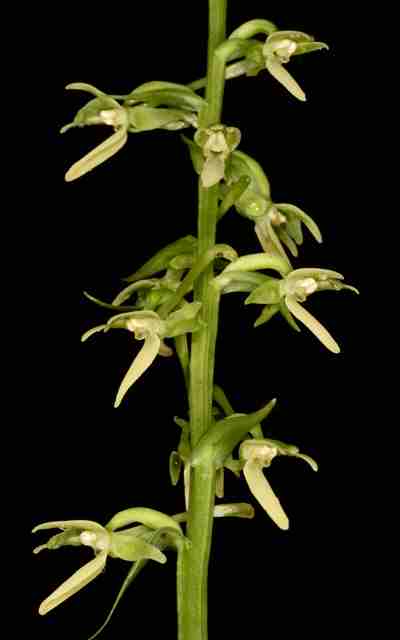The Plant
Terrestrial. Whole plant 15 to 30 cm in height. With many long, stout and cylindrical roots arising from the base of the stem, no tubers. Stem stout with a small tubular sheath at its base. Leaf four, unequal with the lower most one the largest and diminishing in size upwards, elliptic, narrowed to a long sheathing base, 2 to 8 cm long and 0.7 to 3.5 cm in width. The portion above the uppermost leaf and the spike is with two small unequal lanceolate bracts. Spike shorter than the length of the stem. Flower many, laxly arranged.
The Flower
Flower large, about 3 cm across facing diagonally downwards. Sepals unequal; dorsal concave, shorter than the lateral sepals, diagonally erect; lateral lanceolate, with its apex margins on the lower side much curved to a form a sickle shape, spreading and bend backwards. Petals linear to lanceolate, diagonally erect, longer and arranged parallel to the sides of the dorsal sepal, one nerved. Lip lanceolate longer than the sepals and petals, pointing downwards. Spur straight, longer than the ovary, cylindrical with its broader apex and slightly curved. Floral bracts lanceolate, longer than the ovary, decurved to spreading, diminishing in length to towards the apex of the spike, arising from the lower base of the twisted and curved ovary.
Sepals pale green, petals and lip pale yellow, spur pale green and translucent. The outer margins to the entrance of the spur are bright orange. Floral bract green.

The Pursuit
This is one of the undocumented species from the region. As usual many publications came out with its descriptions and drawings, a virtual “cut and paste” theory. The drawings of this species by Pantling got my attention particularly its long lip. In the alpine region I trekked extra miles in pursuit for this particular species than any other species. However, for many weeks it remained elusive.
On a sunny day, we were on a trek to the hilltop through a motorable road. As that road was made for vehicular transport it got long curves and walking all the way up was time consuming. Hence, on the way uphill we were by passing many turnings by taking shortcuts through the adjoining forests. On the third short cut one of the villager who was accompanying me found a single plant of this species accidentally. From the pattern of its leaves I identified the plant. However, the buds were just emerging and on close observation it was understood that they would open after a couple of weeks only. I marked the location and set a date after 12 days to visit the location again. My curiosity about its flowers made me visit the location on the 11th day. By then, some wild animals also took that short cut root and destroyed the plant. I was really saddened to see the crushed and dried state of the plant. In the wild, these types of incidents will happen; after all we were in their territory!!!
We searched the whole area in the next few days in vain. After a week I was left with no company for the trek as everyone was on vacation. I was concentrating on an area, which was immensely dense forest. I over came the fear of being alone and worked every day. On one afternoon, I felt the presence of some wildlife inside the forest and decided to move down hill immediately. As I was swiftly descending down hill I found two plants of this species underneath a thick Rhododendron tree. The thick trunk of the tree was wide enough to hide it from me. But, my sharp eyes found those plants. As I was very familiar with the Pantling’s drawings about the species, I immediately identified it. Then I was left with a dilemma, whether to study and document it then and there or come again the next day. The previous experience with the same species made me open my backpack and pull out my notebook and camera. I was concentrating for the next 15 to 30 minutes totally on the plants and I was oblivious about the wildlife movement around. As I was documenting the flowers again I noticed some movement some 10 m away from me. It was two grown bears, a mother and a calf. I understood the danger and swiftly moved to hide behind a tree. As the wind was towards me they were not able to find my location. After 15 minutes of tense moments both the bears walked back to the deep regions of the woods. I continued with my work, giving more attention on the bears than the plant. After documenting it and taking notes as fast as I could I too ran down to safety. After reaching down hill on the road, I opened my backpack to arrange the equipment and found out that I left one of my flashes at the location. As rains were common in those heights everyday, I know the evening rains will damage the flash, if I left it there. Hence, I made another tedious and tense climb again to collect the flash unit. By God’s grace there was no trace of those bears then.
Reference:
King, G. & Pantling, R. (1898). The Orchids of the Sikkim-Himalayas. Ann. Roy. Bot. Garden. (Calcutta). Habenaria stenantha Hook., Page no: 314.